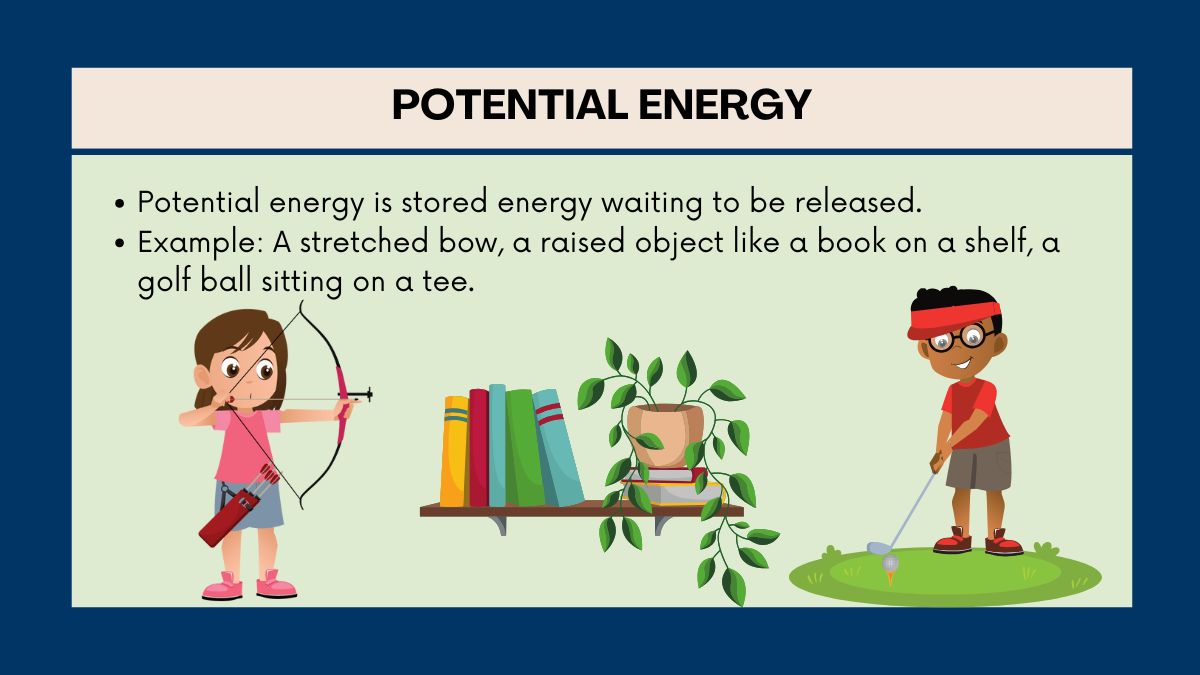Work and Energy
Simply put, if you apply force to an object and it moves in the direction of force then you do work. So when you are exerting force on an object making it move, you are doing work, for example, if you push a toy car & it moves. P (Work) is measured in joules, the energy unit.
Here’s a simple framework to understand it:
-
If you shove a box, and it glides across the floor, you're doing work.
-
If you are trying to push & you push that box again but it doesn't move, no work is done at this state (even if you are trying to)!
Fun Fact:
Did you know that work happens when you’re exercising? When you lift weights or even push a sled, you are applying force & moving something—so you're doing work!
What is Energy?
Energy is the ability to do work. Without energy, nothing would move or happen! Energy can take many forms:
-
Kinetic Energy (energy of motion) –
like when you’re running or a car is speeding down the road.
.jpg)
-
Potential Energy (stored energy) –
like a book on a shelf before it falls or a stretched rubber band.
When you use energy to do work, the energy gets transferred. For example, when you push a toy car, your muscles use energy to make the car move.

How Work and Energy Are Connected
Work and energy are closely related. When you do work on an object, you transfer energy to it. If you lift a heavy box, you give it gravitational potential energy, and it’s ready to fall back down. The energy used to lift it is what makes the box capable of falling!
Think of it like this: Energy is the fuel, & work is what happens when that fuel is used!
Fun Question Time!
-
If you push a box & it doesn’t move, are you doing work?
(Answer: No, because the box didn't move!)
-
Can you do work without using energy?
(Answer: Nope, you need energy to do work!)
Types of Energy You See Every Day
-
Mechanical Energy –
It is the energy an possesses owing to its motion or position. Mechanical energy is present in a moving car or a flying kite.
-
Heat Energy –
Have you ever felt warmth from a fire? That’s heat energy, transferred from one location to another.”
-
Electrical Energy –
Charging your cell phone? That’s electrical energy, passing through wires to power your devices.
-
Sound Energy –
Every time you clap your hands, you create sound energy!
Let's See How Work is Done!
Now, imagine picking a backpack off the ground. You exert pressure on the backpack, & it goes up. When you do this, you build gravitational potential energy into the backpack because it’s now higher up and could simply fall if you let go.
This is a neat example of how work & energy are closely related!
What is Work and Energy?
Work is considered to be done when a force acts on an object & causes it to move. Work in physics is given by multiplying the force acting on an object with the distance it moves in the direction of the force. And the unit of work is the joule (J).
Work Energy is the ability or capacity to do some work. Energy comes in many forms: kinetic energy (energy of motion), potential energy (stored energy), thermal energy (heat), & more. Energy is transferred from one object to another or transformed from one form into another. Energy is measured in joules (J).
5 Differences Between Work and Energy
-
Definition:
-
Work, is the application of a force that moves an object.
-
Energy: the capacity to do work or to bring about change in an object.
-
Nature:
-
Force questioning in this case refers to applying force when force is being applied as work.
-
The termEnergy is defined as the ability or potential to do work.
-
Unit:
-
Work & energy have units of joules (J).
-
Transfer:
-
Doing work is transferring energy from one object to another through motion.
-
Energy has many forms and is not always transferred (as in the stored energy in an object).
-
State:
-
Work is more of a process or even an event, such as lifting an object.
-
Energy exists as potential energy (stored), & kinetic energy (motion).
What is the Relationship Between Energy and Work?
Task is closely associated with vitality. You transfer energy to the object when you do work on it. This energy can be kinetic energy (if the object is set in motion) or potential energy (if you, say, lift it higher).
The main concept is that work is how energy is transferred or transformed. When you push a box, you put in energy (from your muscles), and in exchange, you transfer energy to the box & it moves. Energy, too, can be converted from one kind of energy to another — like kinetic energy when a moving car comes to a halt & its energy becomes heat (from friction).
To summarize: Work is the transfer of energy. Work is done whenever energy is transferred to an object!

